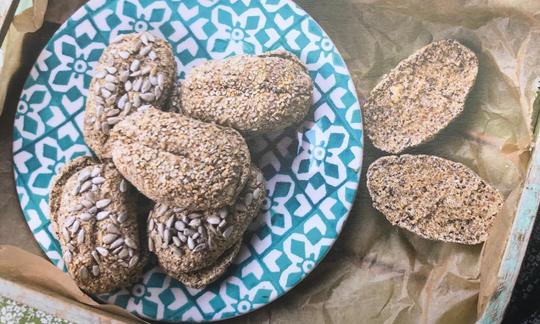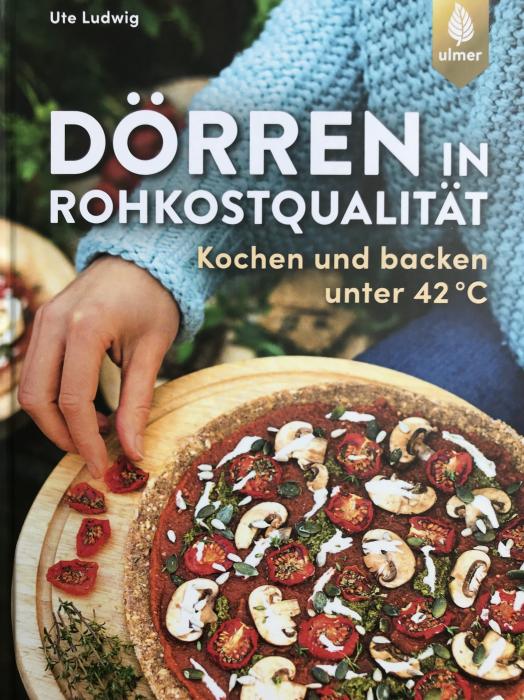Sunday Brunch Rolls (Raw) with Almond Pulp and Flaxseed
raw-vegan
Ingredients (for servings, )
| Homemade almond milk (save the pulp) | |
|---|---|
| 200 ml | Almond milk (raw?, organic?) (6.7 oz) |
| For the dough | |
| 3 tbsp | Chia (chia seeds), raw, organic? (0.55 oz) |
| 100 ml | Drinking water, raw (organic?) (3.5 oz) |
| 3 ½ oz | Oat flakes (raw?, organic?) |
| 1 ¾ oz | Linseed, raw, organic? (golden linseed, flax) |
| 3 tbsp | Coconut flour, raw? organic? (1.2 oz) |
| 3 tbsp | Rapeseed oil (canola, HOLL oil, kernel oil), cold pressed?, organic? (1.5 oz) |
| ½ tsp | Table salt (table salt, raw?, organic?) (0.11 oz) |
Equipment
- hand-held blender / immersion blender
- food processor
- dehydrator
- nut milk bag
- coffee grinder, electric
Type of preparation
- dehydrate
- chop or grind
- food preparation without heating
- soak
- blend
- strain
- knead
Preparation
Making your own almond milk — saving the almond pulp
For this recipe, you will need both the almond milk and the leftover almond pulp. You can prepare the milk in advance. Simply soak about 200 g almonds (4–12 hours) and then blend with about 800 mL water and pass through a nut milk bag.A more detailed recipe can be found here.
For the dough
Combine the chia seeds with 100 mL water and let soak.Grind the rolled oats and place in a food processor with an S-blade. Grind the flaxseed in a coffee grinder and then add to the rolled oats. Add the coconut flour to the mixture as well and then process briefly, until everything is well mixed.
Purchase raw rolled oats or make your own raw rolled oats from oat groats (see page 63 of this cookbook).
The author uses golden flaxseed. These don’t have quite as good ratio of omega-3 to omega-6 fatty acids, but they do tend to gel better (better choice for flax seed gel).
Add 150 g of the almond pulp that was leftover from making the almond milk (see Step 1), the chia seed gel (Step 2), the canola oil, 200 mL almond milk (Step 1), and the salt and mix until the dough is smooth.
Shaping and dehydrating the rolls
Use your hands to shape the dough into 6 rolls. Garnish with seeds of your choice. Place on a dehydrator tray and dehydrate for 2 hours.
Cut the rolls in half and then dehydrate 3–5 hours longer or until the rolls have achieved the desired consistency.For shaping the rolls: the total number of rolls is equal to the number of servings.
Use within 2–3 days.
|
Nutritional Information per person
Convert per 100g
|
2000 kcal | |
|---|---|---|
| Energy | 203 kcal | 10.2% |
| Fat/Lipids | 14 g | 19.5% |
| Saturated Fats | 1.8 g | 9.2% |
| Carbohydrates (inc.dietary fiber) | 18 g | 6.7% |
| Sugars | 1.3 g | 1.5% |
| Fiber | 7.0 g | 28.0% |
| Protein/Albumin | 5.5 g | 10.9% |
| Cooking Salt (Na:218.8 mg) | 556 mg | 23.2% |
| Essential micronutrients with the highest proportions | per person | 2000 kcal | |
|---|---|---|---|
| Fat | Alpha-Linolenic acid; ALA; 18:3 omega-3 | 3.0 g | 151.0% |
| Min | Manganese, Mn | 1.0 mg | 50.0% |
| Prot | Tryptophan (Trp, W) | 0.08 g | 31.0% |
| Elem | Phosphorus, P | 191 mg | 27.0% |
| Sodium, Na | 219 mg | 27.0% | |
| Min | Copper, Cu | 0.24 mg | 24.0% |
| Fat | Linoleic acid; LA; 18:2 omega-6 | 2.4 g | 24.0% |
| Vit | Vitamin B1 (Thiamine) | 0.23 mg | 21.0% |
| Elem | Magnesium, Mg | 73 mg | 20.0% |
| Prot | Threonine (Thr, T, irreversibly transaminated) | 0.19 g | 20.0% |
Detailed Nutritional Information per Person for this Recipe
The majority of the nutritional information comes from the USDA (US Department of Agriculture). This means that the information for natural products is often incomplete or only given within broader categories, whereas in most cases products made from these have more complete information displayed.
If we take flaxseed, for example, the important essential amino acid ALA (omega-3) is only included in an overarching category whereas for flaxseed oil ALA is listed specifically. In time, we will be able to change this, but it will require a lot of work. An “i” appears behind ingredients that have been adjusted and an explanation appears when you hover over this symbol.
For Erb Muesli, the original calculations resulted in 48 % of the daily requirement of ALA — but with the correction, we see that the muesli actually covers >100 % of the necessary recommendation for the omega-3 fatty acid ALA. Our goal is to eventually be able to compare the nutritional value of our recipes with those that are used in conventional western lifestyles.
| Essential fatty acids | per person | 2000 kcal |
|---|---|---|
| Alpha-Linolenic acid; ALA; 18:3 omega-3 | 3.0 g | 151.0% |
| Linoleic acid; LA; 18:2 omega-6 | 2.4 g | 24.0% |
| Essential amino acids | per person | 2000 kcal |
|---|---|---|
| Tryptophan (Trp, W) | 0.08 g | 31.0% |
| Threonine (Thr, T, irreversibly transaminated) | 0.19 g | 20.0% |
| Valin (Val, V) | 0.30 g | 19.0% |
| Isoleucine (Ile, I) | 0.22 g | 18.0% |
| Leucine (Leu, L) | 0.39 g | 16.0% |
| Phenylalanine (Phe, F) | 0.23 g | 15.0% |
| Lysine (Lys, K, irreversibly transaminated) | 0.26 g | 14.0% |
| Methionine (Met, M) | 0.10 g | 11.0% |
| Vitamins | per person | 2000 kcal |
|---|---|---|
| Vitamin B1 (Thiamine) | 0.23 mg | 21.0% |
| Vitamin E, as a-TEs | 1.9 mg | 16.0% |
| Vitamin B7 (Biotin, ex vitamin H) | 5.9 µg | 12.0% |
| Vitamin K | 5.7 µg | 8.0% |
| Vitamin B9, B11 (Folate, as the active form of folic acid) | 15 µg | 7.0% |
| Vitamin B2 (Riboflavin) | 0.09 mg | 6.0% |
| Vitamin B3 (Niacin) | 0.89 mg | 6.0% |
| Vitamin A, as RAE | 52 µg | 6.0% |
| Vitamin B5 (Pantothenic acid) | 0.27 mg | 5.0% |
| Vitamin B6 (pyridoxine) | 0.06 mg | 5.0% |
| Vitamin C (ascorbic acid) | 0.09 mg | < 0.1% |
| Essential macroelements (macronutrients) | per person | 2000 kcal |
|---|---|---|
| Phosphorus, P | 191 mg | 27.0% |
| Sodium, Na | 219 mg | 27.0% |
| Magnesium, Mg | 73 mg | 20.0% |
| Calcium, Ca | 92 mg | 12.0% |
| Potassium, K | 199 mg | 10.0% |
| Essential trace elements (micronutrients) | per person | 2000 kcal |
|---|---|---|
| Manganese, Mn | 1.0 mg | 50.0% |
| Copper, Cu | 0.24 mg | 24.0% |
| Selenium, Se | 8.4 µg | 15.0% |
| Zinc, Zn | 1.2 mg | 12.0% |
| Iron, Fe | 1.6 mg | 11.0% |
| Iod, I (Jod, J) | 2.1 µg | 1.0% |
| Fluorine, F | 12 µg | < 0.1% |
"Drying in raw food quality - Cooking and baking below 42 °C" contains many classic and health-conscious recipes as well as valuable practical tips.
Since this book is written in German, a description is omitted here. If you are interested, please switch to German in the menu.
These tasty Sunday brunch rolls made with almond pulp and flaxseed are dehydrated instead of baked. Make sure to buy raw rolled oats that have not been steamed.
Ingredients and number of servings: The amounts listed for the ingredients are enough to make 6 rolls.
Nutritional profile: According to GDA guidelines, a serving of this recipe meets the recommended daily requirement for manganese. In addition, it covers 80% of the recommended daily requirement for vitamin E and over 50% of the requirement for copper and the essential amino acid tryptophan. At 1:1, the ratio of omega-6 to omega-3 fatty acids is significantly under the maximum recommended ratio of 5:1.
Rolled oats: Rolled oats contain high levels of protein and many essential amino acids. And they are also rich in vitamins and minerals—but depending on the processing (heat and steam), they may contain fewer vitamins. This recipe is only truly raw if you use raw rolled oats. People who suffer from a gluten intolerance (celiac disease) have an immune reaction against gliadin, but they can tolerate glutenin. This means that they have to avoid traditional grains such as wheat, but that they can usually eat oats. However, it must first be verified that the oats did not come into contact with wheat or other grains containing gluten during processing and that they were cleaned in a special manner. You can purchase rolled oats that fulfill these requirements; they are labeled as gluten-free rolled oats.
Chia seeds: Chia seeds, originally from Mexico, stand out on account of their high levels of calcium, iron, soluble fiber, and omega-3 fatty acids.
Flaxseed: Flaxseed are the seeds of the flax plant (common flax or linseed: Linum usitatissimum). They have a slightly nutty flavor and contain 40 % fat. Since this consists of about 50 % polyunsaturated omega-3 fatty acids (ALA), flaxseed oil has the highest concentration of omega-3 fatty acids of all known vegetable oils. People who eat a lot of convenience foods should increase the amount of flaxseed in their diet in order to in this respect somewhat compensate for poor dietary choices.
Golden vs brown flaxseed: Although both varieties come from the same plant, they have a different nutritional profile and gel properties. Golden flaxseed gel better and are a better choice for flax seed gel; however, they have a poorer ratio of fatty acids (more omega-6 and less omega-3).
Storing chia seeds: Chia seeds can be stored for up to five years and are as such much more suited for long-term storage as opposed to, for example, flaxseed. To obtain optimal storage conditions, make sure you have a good seal (e.g., screw-top jar) and that you store the chia seeds in a cool (but not moist), dark place.
Getting the most from chia seeds: Our body can reap the benefits of these substances best when the chia seeds are ground since the whole seeds primarily function as fiber. Getting enough omega-3 fatty acids in our diet should take higher priority. Please click on the link to read more in the following article: A Vegan Diet Can Be Unhealthy. Nutrition Mistakes.
No food processor?: If you don’t have a food processor, you can also make this recipe by first using a blender and then kneading the dough by hand.
Making your own rolled oats: To do this, you start by soaking oat groats overnight and then dehydrating them. (see page 63 of this cookbook).




